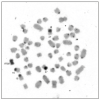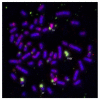Supernumerary Marker Chromosome Identified in Asian Elephant (Elephas maximus)
- PMID: 36830488
- PMCID: PMC9952010
- DOI: 10.3390/ani13040701
Supernumerary Marker Chromosome Identified in Asian Elephant (Elephas maximus)
Abstract
We identified a small, supernumerary marker chromosome (sSMC) in two phenotypically normal Asian elephants (Elephas maximus): a female (2n = 57,XX,+mar) and her male offspring (2n = 57,XY,+mar). sSMCs are defined as structurally abnormal chromosomes that cannot be identified by conventional banding analysis since they are usually small and often lack distinct banding patterns. Although current molecular techniques can reveal their origin, the mechanism of their formation is not yet fully understood. We determined the origin of the marker using a suite of conventional and molecular cytogenetic approaches that included (a) G- and C-banding, (b) AgNOR staining, (c) preparation of a DNA clone using laser microdissection of the marker chromosome, (d) FISH with commercially available human painting and telomeric probes, and (e) FISH with centromeric DNA derived from the centromeric regions of a marker-free Asian elephant. Moreover, we present new information on the location and number of NORs in Asian and savanna elephants. We show that the metacentric marker was composed of heterochromatin with NORs at the terminal ends, originating most likely from the heterochromatic region of chromosome 27. In this context, we discuss the possible mechanism of marker formation. We also discuss the similarities between sSMCs and B chromosomes and whether the marker chromosome presented here could evolve into a B chromosome in the future.
Keywords: Asian elephant; FISH; NOR; heterochromatin; karyotype; laser microdissection; sSMC; savanna elephant; small supernumerary marker chromosome.
Conflict of interest statement
The authors declare no conflict of interest.
Figures







Similar articles
-
Molecular cytogenetic characterization of eight small supernumerary marker chromosomes originating from chromosomes 2, 4, 8, 18, and 21 in three patients.J Appl Genet. 2007;48(2):167-75. doi: 10.1007/BF03194675. J Appl Genet. 2007. PMID: 17495351
-
Small supernumerary marker chromosomes derived from chromosome 14 and/or 22.Mol Cytogenet. 2021 Feb 25;14(1):13. doi: 10.1186/s13039-021-00533-6. Mol Cytogenet. 2021. PMID: 33632263 Free PMC article.
-
Identification of small marker chromosomes using microarray comparative genomic hybridization and multicolor fluorescent in situ hybridization.Mol Cytogenet. 2016 Aug 8;9:61. doi: 10.1186/s13039-016-0273-5. eCollection 2016. Mol Cytogenet. 2016. PMID: 27508004 Free PMC article.
-
Overrepresentation of small supernumerary marker chromosomes (sSMC) from chromosome 6 origin in cases with multiple sSMC.Am J Med Genet A. 2006 Jan 1;140(1):46-51. doi: 10.1002/ajmg.a.31048. Am J Med Genet A. 2006. PMID: 16333826 Review.
-
Small supernumerary marker chromosomes and their correlation with specific syndromes.Adv Biomed Res. 2015 Jul 27;4:140. doi: 10.4103/2277-9175.161542. eCollection 2015. Adv Biomed Res. 2015. PMID: 26322288 Free PMC article. Review.
Cited by
-
Does chromoanagenesis play a role in the origin of B chromosomes?Heredity (Edinb). 2025 Apr 19. doi: 10.1038/s41437-025-00758-w. Online ahead of print. Heredity (Edinb). 2025. PMID: 40253498 Review.
References
-
- Trifonov V., Fluri S., Binkert F., Nandini A., Anderson J., Rodriguez L., Gross M., Kosyakova N., Mkrtchyan H., Ewers E., et al. Complex rearranged small supernumerary marker chromosomes (sSMC), three new cases; evidence for an underestimated entity? Mol. Cytogenet. 2008;15:1–6. doi: 10.1186/1755-8166-1-6. - DOI - PMC - PubMed
-
- Liehr T. The sSMC Homepage. [(accessed on 14 January 2023)]. Available online: https://cs-tl.de/DB/CA/sSMC/0-Start.html.
Grants and funding
LinkOut - more resources
Full Text Sources

